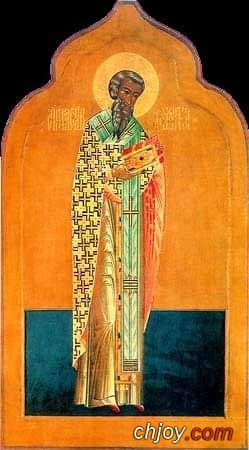
 |
 |
 |
 |
|
رقم المشاركة : ( 1 )
|
|||||||||||
|
|||||||||||
|
الشهيد باسيليوس اسقف آماسيا  كان هذا القدّيس أسقفـًا على مدينة أماسيا في إقليم البنطس في أيّام الملك ليكينيوس الذي كان يضطهد المسيحيِّين ويسفك دماءَهم أنهارًا ويُزاحم الملك قسطنطين الكبير على الملك. فألقى القبض على باسيليوس وبدأ يوبِّخه ويهدِّده بالموت إن لم يكفر بالمسيح ويضحّي للأوثان. فأزدرى به القدِّيس ولم يعبأ بتهديداته بل أخذ يبيِّن له عن ضلاله وعن جوره في اضطهاد المسيحيِّين الآمنين وسفك دمائهم، وإنّ الله سيعاقبه على معاصيه. فاستشاط الملك غيظًا وأمر به فضرب عنقه، ففاز بالشّهادة والمجد السَّماوي وكان ذلك نحو سنة 322. وقد تمّت نبوءة هذا القدّيس الشّهيد في الملك ليكينيوس ، لأنّ قسطنطين قد انتصر عليه ومات مقتولاً سنة 323. Martyr Basil, Bishop of Amasia The PriestMartyr Basil, Bishop of Amasea, lived at the beginning of the IV Century in the Pontine city of Amasea. He encouraged and comforted the Christians, suffering persecution by the pagans. During this time the Eastern part of the Roman empire was ruled by Licinius (312-324), a relative by marriage to the holy Equal-to-the-Apostles emperor Constantine the Great (306-337, Comm. 21 May). Licinius deceitfully undersigned Constantine's "Edict of Religious Toleration" (313), which permitted the freely open confession of Christianity, but at heart he hated Christians and continued to persecute them to return to paganism. Licinius burned with passion for a maid-servant of his wife Constancia, – the Righteous Virgin Galphyra. The holy maid reported about this to the empress and sought her intercession. Having dressed her in men's attire and provided her with money, the empress Constancia sent her away from the city in the company of a devoted servant. They told the emperor, that the maid-servant had gone mad and lay near death. Righteous Glaphyra on the road to Armenia remained in the city of Amasea, where the local bishop, Saint Basil, gave her shelter. At this time the saint was building a church in the city. Righteous Glaphyra for its construction gave over all the money that she had received from Constancia, and in a letter to the empress she besought her to send additional funds to complete the church. The empress fulfilled her request. But the letter of Righteous Galphyra fell into the hands of the emperor. The enraged Licinius demanded the governor of Amasea to send him the sainted-hierarch and the maid-servant. Righteous Galphyra died (+ 322) before the edict arrived in Amasea. They dispatched Saint Basil to the emperor. Two deacons, Parthenias and Thestimos, followed after him and lodged near the prison where they locked up the saint. The pious Christian Elpidyphoros bribed the jailer and each night together with Parthenias and Thestimos he visited the saint. On the eve of the trial day of the saint he sang psalms and the words "if I be at the very depths of the sea, even there wilt Thy hand guide me and Thine right hand hold me" (Ps. 138 [139]: 9-10) – and thrice he broke down into tears. The deacons were apprehensive that the saint would be in distress over the coming torments, but he calmed them. At the trial Saint Basil resolutely refused the suggestion of the emperor to become a pagan high-priest, and therefore he was sentenced to death. Elpidyphoros got to the soldiers with money, and they allowed the saint to pray and to speak with his friends before the execution. After this, the saint said to the executioner: "Friend, do what thou art ordered to", – and calmly he bent beneathe the blow of the sword. When the martyr had been beheaded, Elpidyphoros tried to ransom his remains from the soldiers. But the soldiers were afraid of the emperor and they threw the body and head of the saint into the sea. After this, three times in a dream an Angel of God appeared before Elpidyphoros with the words: "Bishop Basil is in Sinope and doth await you". Heeding this call, Elpidyphoros and the deacons sailed to Sinope and there they hired fishermen to lower their nets. When they lowered the net "on the suggestion" of the deacons Thestimos and Parthenias, they came up with nothing. Thereupon Elpidyphoros declared, that he would ask them to lower the net in the Name of the God, Whom he did worship. This time the net brought up the body of Saint Basil. The head had come back together with it, and only the gash on the neck indicated the strike of the sword. The relics of Saint Basil were conveyed to Amasea and buried in the church built by him. |
 |
| أدوات الموضوع | |
| انواع عرض الموضوع | |
|